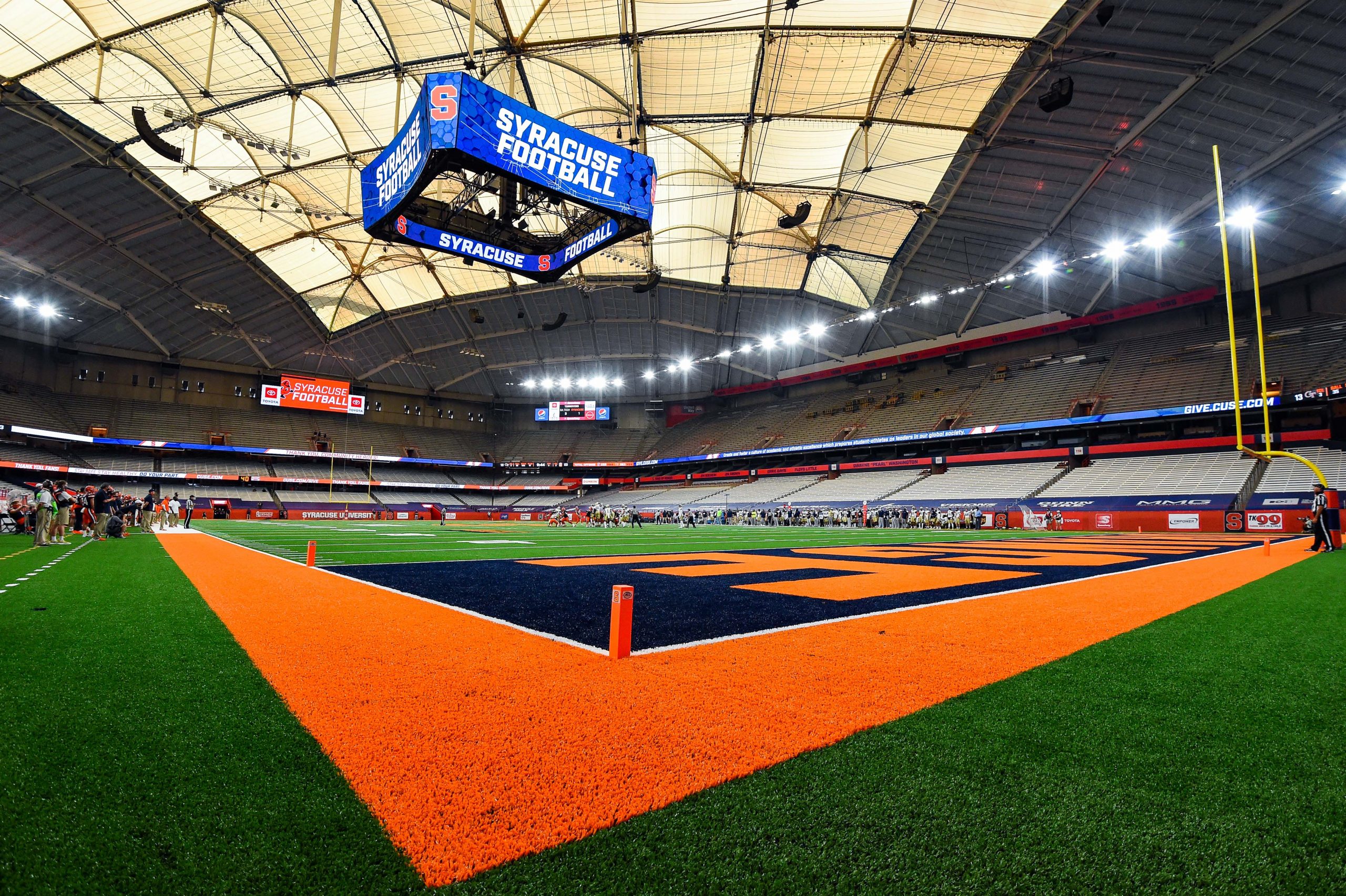Technology Drives State of the Art for Sports-Venue Video
Venue imaging continues to become bigger, sharper, louder
Story Highlights
Video displays in sports venues come in all shapes and sizes but share a common thread: technology is driving them bigger, brighter, sharper, curvier, and, when they integrate audio systems, louder.
“Technology is driving what displays can do,” says Will Ellerbruch, national sales manager, live events, Daktronics, who recited the evolution from the 480-pixel/4×3 configurations of the standard-definition era through the 720-, 1,080-, and 1,920-pixel and then the 4K 16×9 configurations of today, with 8K looming in the future.
At the same time, resolution, which is also known as pitch and determines the sharpness of images, has also tightened: outdoor displays now regularly achieve single-digit resolution, and some indoor displays have achieved pitches at tight as 0.7 mm, way down from the blurry 30-plus densities of even 20 years ago.

At 7,022 sq. ft., the new centerhung videoboard at Syracuse University’s Carrier Dome is the largest in collegiate athletics.
“The technology of video is the main driver,” says Ellerbruch, citing the 7,000+-sq.-ft. centerhung screen that Daktronics installed over the summer at Syracuse University, the largest centerhung system in college sports and the fourth-largest indoor centerhung system on the continent. “You decide the image and resolution you want, and that determines the physical size [of the display], not the other way around.”
At the same time, the cost of these ever-sharper displays continues to decline, from millions of dollars for Mitsubishi/Sony’s original Jumbotron — the largest such scoreboard ever installed, the 110- x 33-ft. Jumbotron at Toronto’s Rogers Centre in the 1980s, cost $17 million — to a fraction of that today for HD resolution. Midsize HD displays can be had for low to mid six figures, making them affordable even for high school stadiums and meaning that cost is no longer a barrier to size or pitch.
Audio components for scoreboards have seen similar pricing dynamics, although that has been driven through competition, mainly by more vendors entering the U.S. and European markets.
Metrics Change
Display sizes are reaching new scales. SoFi Stadium in Los Angeles, the new home of both the NFL’s Rams and Chargers, boasts a 70,000-sq.-ft., 4K, dual-sided Samsung LED videoboard, which uses nearly 80 million pixels to achieve an 8-mm pitch and weighs a staggering 2.2 million lb.
As the technology behind large-scale video evolves, the emphasis will shift from simple size comparisons to more-nuanced metrics. The focus is already moving from pitch to processing, notes Brice McPheeters, director, product line management and customer experience, Nanolumens, which has curved displays in such venues as the Atlanta Braves’ SunTrust Park and the Miami Heat’s American Airlines Arena.
“The human eye can process only so much resolution,” he explains, “so it becomes a matter of how smoothly motion is captured and processed for the display. The focus is now on the quality of the processing, incorporating technologies like HDR, looking at color and bit depth.”
McPheeters says that’s bringing more third-party processing to the fore, from such companies as Brompton, MegaPixel VR, and NovaStar, which will help display manufacturers keep up with display suppliers that have developed their own high-powered processors. Samsung is one such supplier, drawing on its consumer division’s work.
Content Is (Still) King
A massive video display, often surrounded by lots of other video in the form of ribbon boards and digital signage, has come to be expected in sports venues. However, the displays have progressed from entertaining novelties to information conduits that keep audiences apprised of scores in the venue and elsewhere, fan-engagement devices replicating the replays that fans get on their home televisions, and even entertainment centers unto themselves.
That, says Ellerbruch, is putting more and more emphasis on original and compelling content and putting it in more and more places in the venue. Stadiums are being pushed to provide content that fans can’t get at home, such as different camera angles. 3D, which has thus far flopped in the home video market, may yet find a place on the huge, high-resolution displays in stadiums.

A 72-foot-long Daktronics video display lines in the tunnel between the “Hall of Champions” and the locker room at the University of Alabama.
“The video displays themselves can handle 3D, and we’ve played with it a bit,” he says. “What’s holding it back is that the backside [infrastructure] isn’t there for 3D at that scale yet.”
Fans can now have a video experience that’s seamless from their seat to the concessions and concourses. Video has also been extended to large displays on the exteriors of stadiums and arenas, entertaining overflow and crowds standing on line and used also as advertising and marketing tools during off seasons.
More recently, video is extending to other areas deeper inside the venues. Daktronics this year installed a 72-ft.-long, 1.9-mm video display in the tunnel between the “Hall of Champions” and the locker room at the University of Alabama. Inside the locker room, 90-in. touchscreen displays are rapidly replacing the whiteboards long used to illustrate plays.
Displays have reached the point where they are an integral architectural consideration.
“Most stadiums and arenas have a natural curve to their architecture, which is something that large LCD displays couldn’t take advantage of,” says McPheeters. “Now the displays are being considered as part of the architectural designs of sports venues. They’re a part of the architecture of the building instead of being an add-on to it.”
Seamless Signage
The intersection of large-scale displays and digital signage represents another expanding tangent for video in venues. While displays on concourses and concessions have become common, the same technology is being used to create entirely new environments.

Toshiba America Business Solutions’ Michael Sullivan expects future stadium video installations to offer an increasingly refined viewing experience.
An example is Toshiba Plaza, the gateway to the T-Mobile Arena in Las Vegas, home of the NHL’s Vegas Golden Knights. The two-acre piazza has three entertainment stages, connections to three nearby resort hotels, and plenty of video signage, but the main focus is the 175-ft.-wide x 45-ft.-high video-mesh wall on the side of the arena.
Sports venues have become “a sea of video,” says Michael Sullivan, director, digital signage, Toshiba America Business Solutions, which has done large-scale digital-signage installations at Mercedes Platz in Berlin, The O2 in London, and LA Live. These displays track, he says, “the fan’s journey from the parking lot to the bowl.” Multicast streaming has also made the connection between bowl and back of house more seamless, he contends, to the point where “the game follows you around the venue.”
Sullivan speculates that future video installations will concentrate less on increased screen sizes and more on refining the viewing experience, with better lighting, more-easily viewable screen coatings, improved image compression, and more viewing angles.
“There’ll be less of a distinction between looking at the scoreboard and looking at the playing field,” he says. “It’ll be almost like a car’s dashboard.”
Big Sound
Some display builders are integrating audio into their scoreboards, a trend most common in college football, whose massive stadiums often use point-source PA systems. Daktronics, for instance, will design and integrate sound systems from manufacturers JBL and Danley Labs into its scoreboard designs. Ellerbruch says, although the company implemented audio as an additional revenue source, it’s just as much a benefit to customers.

At T-Mobile Arena, home to the Vegas Golden Knights, video is a major part of the environment inside and out.
“It’s operationally efficient,” he points out, “since the cabling from [both] video and audio is running back to the same [control room]. And it’s economical since you’re getting a single integrated system from a single supplier.”
The concept of incorporating audio systems into video scoreboards is becoming more common. Samsung’s 4K videoboard at SoFi Stadium features a JBL PA system comprising more than 260 of the stadium’s total 4,500 loudspeakers. Toshiba has the idea under consideration, as does Southpaw Live, the screen vendor that evolved from Panasonic’s venture into scoreboards.
The Future Is Bright(er)
Display manufacturers expect that the boundary between inside and outside the venue will continue to blur, with video showing up everywhere. Greg Stocker, VP, business development, Southpaw Live, which has installations at hybrid sports/entertainment venues, such as Texas Live and Topgolf, believes that the greater implementation of IP technology for audio and video will allow venue video to become more personalized even as it becomes more ubiquitous.
“As control systems for video evolve further,” he predicts, “locations such as suites will be able to access different camera angles and replays on demand.”
Ellerbruch envisions an even more Minority Report-esque future: “It’s headed towards the digital stadium, where the displays and the mobile device like a phone will be completely integrated. We’re at the point where the costs and the technology will let that happen.”
